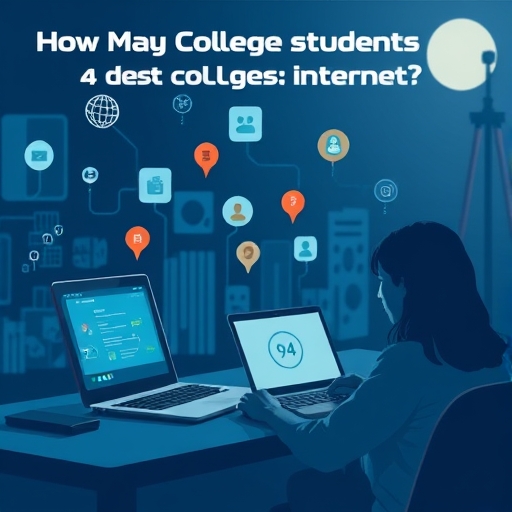How Many College Students Use the Internet?
In today’s digital age, the internet has become an essential tool for education, communication, and social interaction. With the rise of online learning platforms and digital resources, understanding how many college students use the internet is crucial for educators, policymakers, and technology developers. This article delves into the statistics, implications, and trends surrounding internet usage among college students.
The Importance of Internet Usage in Higher Education
The internet plays a pivotal role in the academic lives of college students. It provides them with access to a wealth of information, facilitates communication with peers and instructors, and offers a platform for collaborative learning. Here are some key reasons why internet usage is essential for college students:
- Access to Information: Students can easily find research papers, articles, and educational videos to support their studies.
- Online Learning: Many colleges have embraced online courses, making it necessary for students to be proficient internet users.
- Communication: Email, discussion forums, and social media platforms allow students to connect with their classmates and professors.
- Resource Availability: Libraries and academic databases are increasingly available online, providing students with 24/7 access to scholarly materials.
- General Usage: Approximately 95% of college students report using the internet regularly.
- Daily Access: About 85% of students access the internet on a daily basis.
- Device Usage:
- Smartphones: Around 90% of students use smartphones for internet access.
- Laptops: Nearly 80% rely on laptops for academic purposes.
- Tablets: Approximately 40% use tablets.
- Age: Younger students (ages 18-22) tend to use the internet more frequently than older students (ages 23 and above).
- Gender: Studies show that female students are slightly more likely to use the internet for educational purposes compared to male students.
- Socioeconomic Status: Students from higher socioeconomic backgrounds typically have better access to reliable internet connections and devices.
- Increased Enrollment in Online Courses: Many students now prefer online courses due to their flexibility and accessibility.
- Utilization of Learning Management Systems (LMS): Platforms like Canvas and Blackboard have become integral to the student experience, requiring reliable internet access.
- Increased Engagement: Students use platforms like Facebook, Instagram, and Twitter to connect with peers and share academic resources.
- Professional Networking: LinkedIn has gained popularity among students for career networking and job searching.
- E-books and Digital Journals: Students can access a vast array of e-books and academic journals online, making research more efficient.
- Open Educational Resources (OER): Many institutions are adopting OER, which are freely available educational materials that can be accessed online.
- Digital Divide: Not all students have equal access to high-speed internet or modern devices, particularly those from low-income backgrounds.
- Internet Reliability: Some students may experience unreliable internet connections, affecting their ability to participate in online classes or complete assignments.
- Distraction: The internet can be a source of distraction for students, leading to decreased productivity and focus on academic tasks.
- Providing Wi-Fi Access: Ensuring that campus-wide Wi-Fi is available and reliable is essential for supporting students’ academic needs.
- Offering Technology Assistance: Providing resources and support for students who may struggle with technology can help bridge the digital divide.
- Promoting Digital Literacy: Offering workshops and courses on digital literacy can help students make the most of online resources.
- Increased Use of Artificial Intelligence: AI tools like chatbots and virtual tutors may become commonplace in higher education, enhancing the learning experience.
- Growth of Virtual Reality (VR) and Augmented Reality (AR): These technologies may offer immersive learning experiences, requiring robust internet access.
- Continued Emphasis on Online Collaboration: The trend toward collaborative online projects and group work is likely to persist, necessitating reliable internet access.
Current Statistics on Internet Usage Among College Students
According to recent studies, the vast majority of college students utilize the internet. Here are some statistics that highlight this trend:
| Device Type | Percentage of Students Using |
|---|---|
| Smartphone | 90% |
| Laptop | 80% |
| Tablet | 40% |
Internet Access by Demographics
The usage of the internet among college students can vary by demographics such as age, gender, and socioeconomic status. Here are some key insights:
Trends in Internet Usage Among College Students
Shift Towards Online Learning
The COVID-19 pandemic accelerated the shift towards online learning, prompting many colleges to adopt hybrid or fully online models. This transition has resulted in an increase in internet usage among students. Key trends include:
Social Media and Networking
Social media platforms play a significant role in how college students communicate and collaborate. The following trends have been observed:
Access to Resources
The rise of digital libraries and online academic resources has transformed the way students conduct research. Key points include:
Challenges and Barriers to Internet Access
While the majority of college students have access to the internet, there are still significant challenges and barriers that can impact their educational experience:
The Role of Colleges and Universities
Colleges and universities play a crucial role in ensuring that students have access to the internet and the resources they need to succeed. Here are some initiatives that institutions can implement:
Future Trends in Internet Usage Among College Students
As technology continues to evolve, so will the ways in which college students use the internet. Here are some potential future trends:
Frequently Asked Questions (FAQ)
How many college students use the internet?
Approximately 95% of college students report using the internet regularly, with around 85% accessing it daily.
What devices do college students primarily use to access the internet?
College students primarily use smartphones (90%), laptops (80%), and tablets (40%) to access the internet.
How has the COVID-19 pandemic affected internet usage among college students?
The pandemic has accelerated the shift toward online learning, resulting in increased internet usage as students adapted to hybrid and fully online course models.
What challenges do college students face regarding internet access?
Challenges include the digital divide, unreliable internet connections, and distractions that can impact academic performance.
What initiatives can colleges implement to improve internet access for students?
Colleges can provide campus-wide Wi-Fi access, offer technology assistance, and promote digital literacy programs to ensure all students can benefit from internet resources.
Conclusion
The internet has become an integral part of the college experience for students, facilitating learning, communication, and collaboration. With the vast majority of students utilizing the internet, it is essential for educators and institutions to understand the trends and challenges associated with internet access. By addressing barriers and promoting digital literacy, colleges can create an inclusive environment that supports all students in their academic journeys. As technology continues to advance, the landscape of internet usage in higher education will undoubtedly evolve, presenting new opportunities and challenges for future generations of learners.





